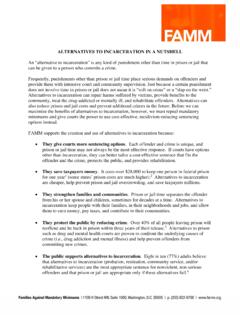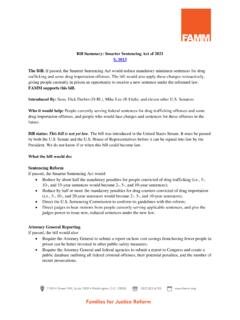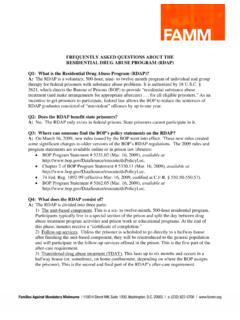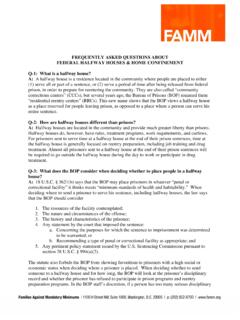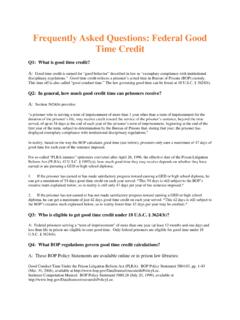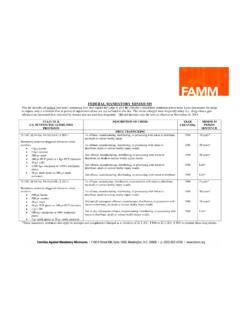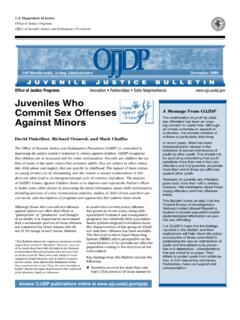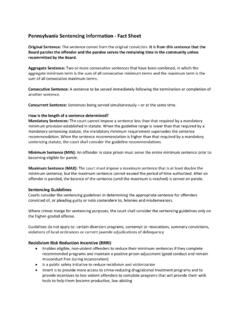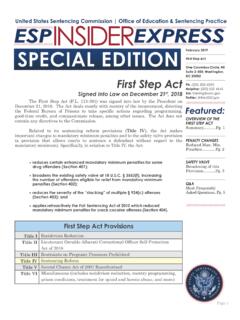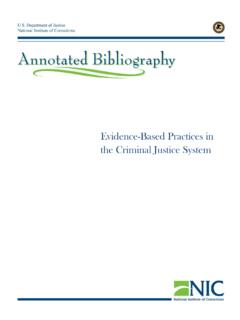Transcription of Frequently Asked Questions on the First Step Act, S. 756 A
1 Frequently Asked Questions on the First Step Act, S. 756 Q1: What does the First Step Act do? A: The First Step Act (S. 756) is a comprehensive criminal justice reform law that reforms some federal mandatory minimum sentencing laws as well as some aspects of the federal prison system. At the core of the Act is a new system that allows some federally incarcerated individuals to earn time credits by completing rehabilitative programming. The individuals considered by the BOP to have a low or minimum risk of reoffending can earn 15 days of credits for each 30 days of programming completed; medium- and high-risk individuals can earn 10 days of credits for each 30 days of programming completed. Some prisoners (see Q10 and Q12, below) can redeem their earned time credits for additional time in a halfway house, home confinement, or supervised release at the end of their sentences.
2 The Act also includes four modest sentencing reform provisions, along with a number of reforms to how we treat individuals in federal prison. Q2: Is the First Step Act law? A: Yes. The First Step Act was signed into law by President Trump on December 21, 2018. Q3: When is the First Step Act effective? A: The sentencing and compassionate release reforms are effective now; other parts of the bill are being phased in over the next three years. Good time and earned time credits Q4: What is the difference between earned time credit and good time credit? A: Earned time credits are a new feature created by the Act. Some individuals can earn time credits by completing rehabilitative programming and engaging in productive activities like helping deliver programming to other prisoners. Depending on a person s risk level, they could earn up to 15 days of credit for every 30 days of programming or productive activities.
3 These time credits can be redeemed by some people for early transfer into a halfway house, home confinement, or supervised release. Earned time credits do not reduce a prisoner s sentence. A number of people are ineligible to receive earned time credits based on the crime they committed (see Q10 for the list of crimes), and non-citizens with immigration detainers cannot redeem earned time credits (see Q12). Good time credits result in real time deducted from a prisoner s sentence and are gained by maintaining good behavior during incarceration. All incarcerated individuals, other than those serving a life sentence, are eligible for good time credits. 2 \Q5: What changes does the First Step Act make to good time credit calculation? A: The BOP currently calculates good time so that prisoners receive up to 47 days off their sentence per year for good conduct. The First Step Act will increase the credit to up to 54 days per year of the sentence imposed.
4 Q6: When can people redeem earned time credits for transfer to pre-release custody? A: Earned time credits can be redeemed when a prisoner s earned time credit balance is equal to or greater than the remainder of their imposed term of imprisonment. In order to redeem earned time credits for transfer, a prisoner must also be assessed as low- or minimum-risk for two consecutive assessments OR have a petition for transfer approved by a warden after the warden determines the prisoner will not be a risk to public safety and is unlikely to recidivate. All prisoners who successfully participate in programming are to have their risk assessed at least once each year, and more Frequently for medium- and high-risk prisoners who are within five years of their release date. The current limits on time in a halfway house (up to 12 months) and home confinement (six months or 10 percent of the sentence, whichever is less) in federal law do not apply to earned time credits.
5 In other words, a person can be released to the halfway house and/or home confinement earlier (for example, so that they spend more than 12 months in halfway house) due to accumulating earned time credits. Q7: When do the new good time credit rules go into effect? A: FAMM believes that Congress intended for the good time credit calculation go into effect immediately, but the language of the law says otherwise. According to the Act, the change to the good time credit calculation goes into effect after the Department of Justice (DOJ) finalizes and releases publicly the risk assessment tool (see Q13). The First Step Act requires that the risk assessment tool be finalized and released publicly no later than 210 days (seven months) after the Act s signing. In other words, no one will see additional good time credit added to their sentence until at least seven months after December 21, 2018, unless the DOJ completes and releases the risk assessment tool sooner than that.
6 Again, FAMM does not believe that is what the sponsors of the legislation intended when they added the good time provision to the bill. As a result, we have reached out to the White House and congressional leaders and are working with other organizations to find a remedy that will allow the good time change to apply as soon as possible. Q8: When does the earned time credit system go into effect? A: Not immediately. The First Step Act gives the DOJ seven months (210 days) to finalize and release publicly the risk assessment tool. After that, the BOP gets six months to apply the tool to every person in federal prison, and two years to create enough programming and productive activities so that all prisoners who are eligible to earn time credits can participate in the program. During this two-year phase-in, prisoners who are closest to their release will get priority to participate in programs or productive activities and earn time credits.
7 After the two-year phase-in, prisoners who are medium- or high-risk will get priority to participate in programs, while low- and minimum-risk prisoners will get priority to participate in productive activities. 3 The Act also gives the BOP the ability to begin expanding existing evidence-based recidivism reducing programs and productive activities and offer incentives and rewards but any credits cannot be redeemed until the system is implemented. In other words, no one will begin to be able to earn time credits for completing programs or productive activities until at least seven months after December 21, 2018, unless the DOJ completes and releases the risk assessment tool sooner than that or the BOP expands existing evidence-based programming or productive activity prior to the completion of the risk assessment tool. Earned-time credits received prior to the implementation of the risk assessment tool will not be eligible for redemption until the tool is implemented.
8 The ability to start earning credits may not actually come for most prisoners until even later than that, depending on how long it takes BOP to apply the risk assessment tool and create programming and productive activities and assign prisoners to them. Q9: Which of the time credit reforms are retroactive good time, earned time, or both? A: Only the additional seven days per year of good time credit will be applied retroactively. This means that prisoners who have not lost good time credit during their sentence will earn an additional seven days for each year of the sentence imposed during which they earned 47 days of good time. For example, a person serving a 10-year sentence who has earned all possible good time credit would receive an extra 70 days of good time credit under the First Step Act. We do not know and the Act does not say how BOP will award good time credit retroactively if a person has, in previous years, lost some or all of their good time credit for rule infractions.
9 Q10: Who is not eligible for earned time credits? A: The First Step Act is the result of political compromise. As part of the compromise, a number of offenders are excluded from receiving earned time credits. These offenders include (but are not limited to) fentanyl traffickers, heroin or methamphetamine traffickers who played a leadership role in the crime, sex offenders, some immigration offenders, all 18 924(c) offenders, and people convicted of other violent offenses. Click here for a complete list of ineligible offenses. Q11: Are there other incentives for those who are unable to receive earned time credits? A: Yes. Offenders who complete rehabilitative programs and who are high-risk or on the list of those not eligible to receive earned time credits are eligible for other incentives. They include increased phone and email time, expanded visitation, and more options at the commissary.
10 The incentives made available will be decided by each prison s warden. Q12: Are non-citizens eligible to earn earned time credits? A: Prisoners with immigration detainers may complete programs and earn time credits, but they are NOT eligible to redeem those earned time credits for additional time in a halfway house, home confinement, or supervised release at the end of their sentences. However, certain offenses related to illegal entry are ineligible to earn time credits (see Q10 for more details). Also, all people who cannot earn time credits may still earn other incentives for program completion, such as more phone minutes, visitation, or commissary privileges (see Q11). 4 Q13: What is the risk assessment tool? A: The BOP currently uses a risk assessment tool to decide which prisons to put people in, based on security level. The First Step Act requires the DOJ to create and use a new risk assessment tool that will be periodically applied to assess each prisoner s risk of reoffending.


